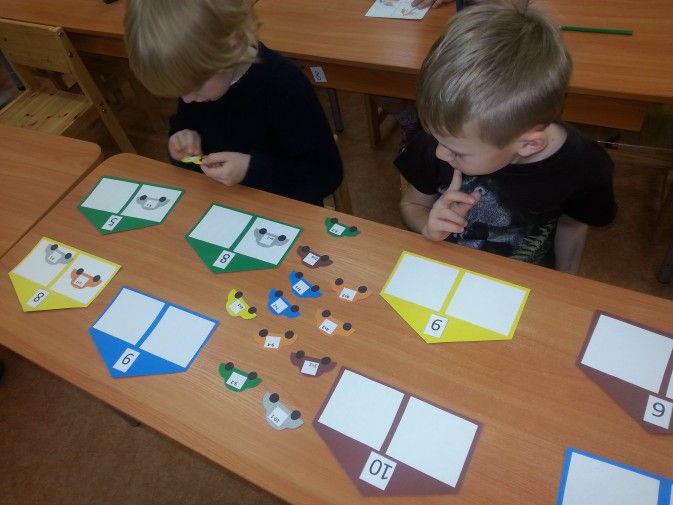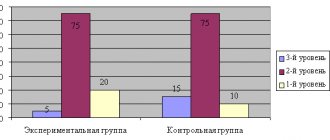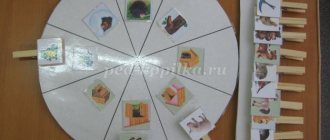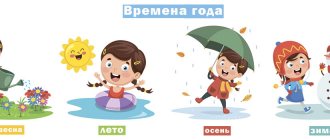MAGAZINE Preschooler.RF
Methodology for organizing didactic gamesThe organization of didactic games by the teacher is carried out in three main directions:
preparation for conducting a didactic game; its implementation and analysis.
Preparation for conducting a didactic game includes:
- selection of games in accordance with the objectives of education and training: deepening and generalizing knowledge, developing sensory abilities, activating mental processes (memory, attention, thinking, speech), etc.;
- establishing compliance of the selected game with the program requirements for the education and training of children of a certain age group;
- Determining the most convenient time for conducting a project. games (in the process of organized learning in the classroom or in free time from classes and other routine processes);
- choosing a place to play where children can play quietly without disturbing others;
- determining the number of players (the whole group, small subgroups, individually);
- preparing the necessary educational material for the selected game (toys, various objects, pictures...);
- preparing the teacher himself for the game: he must study and comprehend the entire course of the game, his place in the game, methods of managing the game;
- preparing children for play: enriching them with knowledge, ideas about objects and phenomena of the surrounding life necessary to solve a game problem.
Conducting didactic games includes:
- familiarizing children with the content of the game, with the material that will be used in the game (showing objects, pictures, a short conversation, during which the children’s knowledge and ideas about them are clarified);
- explanation of the course and rules of the game. At the same time, the teacher pays attention to the children’s behavior in accordance with the rules of the game, to the strict implementation of the rules;
- demonstration of game actions, during which the teacher teaches children to perform the action correctly, proving that otherwise the game will not lead to the desired result (for example, if one of the children is spying when you need to close your eyes);
- determining the role of the teacher in the game, his participation as a player, fan or referee. The degree of direct participation of the teacher in the game is determined by the age of the children, their level of training, the complexity of the task, and the game rules. While participating in the game, the teacher directs the actions of the players (with advice, questions, reminders);
- summing up the game is a crucial moment in its management, because Based on the results that children achieve in the game, one can judge its effectiveness and whether it will be used with interest in children’s independent play activities. When summing up the results, the teacher emphasizes that the path to victory is possible only through overcoming difficulties, attention and discipline.
At the end of the game, the teacher asks the children if they liked the game and promises that next time they can play a new game, it will be also interesting. Children usually wait for this day. The analysis of the game is aimed at identifying the methods of preparing and conducting it: what methods were effective in achieving the goal, what did not work and why. This will help improve both the preparation and the process of playing the game, and avoid subsequent mistakes. In addition, the analysis will allow us to identify individual characteristics in the behavior and character of children and, therefore, correctly organize individual work with them. Self-critical analysis of the use of the game in accordance with the goal helps to vary the game and enrich it with new material in subsequent work.
Guide to didactic games
Successful management of educational games primarily involves selecting and thinking through their program content, clearly defining tasks, determining their place and role in the holistic educational process, and interaction with other games and forms of education. It should be aimed at developing and encouraging children’s cognitive activity, independence and initiative, their use of different ways to solve game problems, and should ensure friendly relations between participants and a willingness to help their comrades.
When playing with toys, objects, materials, small children should be able to knock, rearrange, rearrange them, disassemble them into their component parts (collapsible toys), put them back together, etc. But since they can repeat the same actions over and over again, the teacher needs to gradually transfer the children’s play to a higher level.
For example, the didactic task “teach children to distinguish rings by size” is implemented through the game task “assemble the turret correctly.” Children have a desire to know how to do it right. Demonstration of a method of action contains both the development of a game action and a new game rule. By choosing ring after ring and putting it on the rod, the teacher gives a clear example of the game action. He runs his hand over the put-on rings and draws the children’s attention to the fact that the turret becomes beautiful, even, and that it is assembled correctly. Thus, the teacher clearly demonstrates a new game action - check the correctness of assembling the turret -
invites the children to do it themselves.
The development of interest in didactic games and the formation of play activities in older children (4-6 years old) is achieved by the fact that the teacher sets increasingly more complex tasks for them and is in no hurry to suggest play actions. The play activity of preschoolers becomes more conscious; it is more aimed at achieving a result, and not at the process itself. But even for older preschoolers, the management of the game should be such that the children maintain an appropriate emotional mood, ease, so that they experience the joy of participating in it and a sense of satisfaction from solving the assigned tasks.
The teacher outlines a sequence of games that become more complex in content, tasks, game actions and rules. Individual isolated games can be very interesting, but using them outside the system cannot achieve an overall educational and developmental result. Therefore, the interaction of learning in the classroom and in the didactic game should be clearly defined.
For young children did. play is the most suitable form of learning. However, already in the second, and especially in the third year of life, children are attracted to many objects and phenomena of the surrounding reality, and intensive assimilation of their native language occurs. Satisfying the cognitive interests of children of the third year of life and the development of their speech require a combination of educational games with targeted training in GCD, carried out in accordance with a specific program of knowledge, skills, and abilities. On GCD, methods of learning are also formed more successfully than in the game: voluntary attention, the ability to observe, look and see, listen and hear the instructions of the teacher and carry them out.
It should be taken into account that in did. the game requires the right combination of clarity, the words of the teacher and the actions of the children themselves with toys, play aids, objects, etc. Visibility includes:
1) objects that children play with and which form the material center of the game;
2) pictures depicting objects and actions with them, clearly highlighting the purpose, main characteristics of objects, properties of materials;
3) visual demonstration, explanation of game actions in words and implementation of game rules.
Special did types have been created. games: with paired pictures, such as picture lotto, dominoes with thematic series of pictures, etc. Initial demonstration of game actions by the teacher, trial run, incentive-control badges, chips - all this is also included in the fund of visual aids that are used to organize and guide games .
With the help of verbal explanations and instructions, the teacher directs the children's attention, organizes, clarifies their ideas, and expands their experience. His speech helps to enrich the vocabulary of preschool children, master various forms of learning, and contribute to the improvement of play actions.
When leading games, the teacher uses a variety of means of influence on preschoolers. For example, acting as a participant in the game, he directs the game unnoticed by them, supports their initiative, and empathizes with them the joy of the game. Sometimes the teacher talks about an event, creates the appropriate gaming mood and maintains it during the game. He may not be involved in the game, but as a skillful and sensitive director, preserving and preserving its amateur character, he guides the development of game actions, the implementation of the rules and, unnoticed by the children, leads them to a certain result. When supporting and awakening children's activity, the teacher most often does this not directly, but indirectly: he expresses surprise, jokes, uses various kinds of playful surprises, etc.
We must remember, on the one hand, the danger of over-strengthening the teaching moments, weakening the beginning of the game, and imparting a did. game is the nature of the activity, and, on the other hand, being carried away by the fun, escape from the task of learning.
The development of the game is largely determined by the pace of children’s mental activity, the greater or lesser success of performing game actions, the level of assimilation of the rules, their emotional experiences, and the degree of enthusiasm. During the period of assimilation of new content, new game actions, rules and the beginning of the game, its pace is naturally slower. Later, when the game unfolds and the children get carried away, its pace quickens. By the end of the game, the emotional upsurge seems to subside and the pace slows down again. Excessive slowness and unnecessary acceleration of the pace of the game should not be allowed: an accelerated pace sometimes causes confusion in children, uncertainty, untimely execution of game actions, and violation of the rules. Preschoolers do not have time to get involved in the game and become overexcited. The slow pace of the game occurs when overly detailed explanations are given and many small comments are made. This leads to the fact that game actions seem to move away, the rules are introduced untimely, and children cannot be guided by them, commit violations, and make mistakes. They get tired faster, monotony reduces emotional uplift.
In did. The game always has the opportunity to unexpectedly expand and enrich its concept in connection with the initiative, questions, and suggestions shown by the children. The ability to keep a game within a set time is a great art. The teacher compresses time primarily by shortening his explanations. Clarity and brevity of descriptions, stories, and remarks are a condition for the successful development of the game and the completion of the tasks being solved.
When finishing the game, the teacher should arouse children’s interest in continuing it and create a joyful prospect. Usually he says: “The new game will be even more interesting.” The teacher develops versions of games familiar to children and creates new ones that are useful and exciting.
Pedagogical value of didactic games
- In didactic games, children are given certain tasks, the solution of which requires concentration, attention, mental effort, the ability to comprehend the rules, sequence of actions, and overcome difficulties.
- They promote the development of sensations and perceptions in preschoolers, the formation of ideas, and the assimilation of knowledge. These games make it possible to teach children a variety of economical and rational ways of solving certain mental and practical problems. This is their developing role.
- It is necessary to ensure that didactic play is not only a form of assimilation of individual knowledge and skills, but also contributes to the overall development of the child and serves to shape his abilities.
- The didactic game helps solve the problems of moral education and develop sociability in children. The teacher places children in conditions that require them to be able to play together, regulate their behavior, be fair and honest, compliant and demanding.
When planning you need to:
- Create the required conditions for organizing games indoors and on the site; equip the pedagogical process with games and gaming material in accordance with the age, development and interests of children.
- Observe the time allotted for games during the day; contribute to ensuring that their organization provides children with an interesting, meaningful life.
- In the process of joint play activities, cultivate persistence, endurance, and form positive relationships between children: friendliness, mutual assistance, and the ability to follow the rules.
- Systematically develop gaming skills in children, promote the transformation of play into their independent activity, and encourage the expression of initiative.
Recommendations for planning didactic games
Planning didactic games should occupy a significant place in the planning of all educational work with children. Being an effective teaching tool, they can be an integral part of educational activities, and in an early age group they can be the main form of organizing the educational process. In addition, during the hours allocated for games, games are planned and organized both in joint and independent activities of children, where they can play at will as a whole team, in small groups or individually. The plan should provide for the selection of games and material for them in accordance with the general plan of pedagogical work.
Observations of children’s independent games make it possible to identify their knowledge, their level of mental development, and behavioral characteristics. This can tell the teacher what games are useful for children, what they are strong in, and what they are lagging behind.
- Didactic games are short-term (10-20 minutes);
- It is very important to maintain the child’s enthusiasm for the gaming task throughout the game, to try to ensure that the mental activity of the players does not decrease during this time, and interest in the task at hand does not fall.
It is necessary to provide children with the opportunity to play at different times of the day: in the morning before breakfast, between breakfast and ECD, during breaks between ECD, during a walk, in the afternoon. Games in the morning help create a cheerful, joyful mood in children for the whole day. Everyone can play their favorite games and team up with friends if they wish. It is not uncommon for children to come to kindergarten with certain play intentions and continue the game they started the day before. If breakfast interrupts the game, it is necessary to give the children the opportunity to return to it again after breakfast, during the break between games. In this case, the nature of the upcoming GCD should be taken into account. Before physical education, quiet games are preferable, and if the activity requires a monotonous position, more active outdoor games or verbal games with a motor component are desirable. It is necessary that the time allocated for games be completely devoted to the game. Sometimes, due to children being overloaded with organized educational activities or due to irrational use of time, play time is reduced. This must not be allowed!
When planning didactic games, teachers need to take care of complicating the games and expanding their variability (possibly coming up with more complex rules).
The classes use those games that can be played frontally, with all children. They are used as a method of consolidating and systematizing children's knowledge.
When planning d/games in the educational process, it is necessary that new games taken on GCD are then held in a block of joint activities with children and used by children in their independent activities, being the highest indicator of the ability to engage in activities that require the application of mental effort .
D/games in most cases are held when children have already acquired certain knowledge and skills in classes, otherwise it will be quite difficult to implement the game.
For example, a child, only on the basis of knowledge, can by touch identify an object in a “magic bag” and name it or find similar or different qualities of objects depicted in pictures. These games rely on children's ability to consciously remember and reproduce what they have perceived. It is necessary that all children achieve certain results in children's games, and not just those who are most active.
D/games can also be used to test children’s knowledge and skills. An important indicator of learning outcomes is the assimilation of what has been covered in classes by all children.
Most often, this is checked by playing a game, during which the teacher determines to what extent not only capable, but average and weak children have correctly understood and mastered the content of the GCD. Having identified the level of knowledge and skills of children, it is necessary to outline further work to eliminate deficiencies.
D/game is a practical activity with which you can check whether children have acquired knowledge in detail or superficially and whether they know how to apply it when needed. Children acquire knowledge the more fully the more widely it can be applied in practice in various conditions. It often happens that a child acquires certain knowledge in a lesson, but does not know how to use it in changed conditions.
Due to the fact that e-games are an indispensable means of overcoming various difficulties in the mental development of children, it is necessary to plan the use of e-games in individual work with children. How often and how much? As needed, very individually, depending on the needs and level of development of the children. Individual work with children using d/games can be planned for all types and types of games. Individual games organized by the teacher create favorable conditions for direct contact with the child, help to better understand the reasons for the child’s lag, and contribute to more active practice in the educational material.
In the d/game, knowledge acquired in educational activities is applied, information obtained through personal experience is generalized, cognitive processes are activated and the level of mental development of lagging children is increased.
D/games contribute to the development of all aspects of the human personality. If they are conducted lively and by a skilled teacher, children react to them with great interest and bursts of joy, which certainly increases their significance.
A.M. Gorky, defending the child’s right to play, wrote: “A young child demands games, fun, and his demand is biologically justified and legal. He wants to play, he plays with everyone and learns about the world around him first of all, and most easily in the game, by playing.”
Education should be such that it causes an effort of thought, but does not require tension, does not cause fatigue, fear and reluctance to learn before the child comes to school.
| Next > |
How games are played in kindergarten
The required minimum competence of a teacher is the ability to distinguish didactic games in preschool age from other game forms. The teacher should know:
- structuring;
- varieties;
- database file cabinet;
- regulatory standards.
When using play techniques, the kindergarten teacher must remember that during play the child satisfies his basic needs, and masters activities, work and study. The baby grows as an individual, based on which it is very important to properly organize the game process, approach the matter with full responsibility, relying on the basis of pedagogy.
Kids are playing
Classification of didactic games of preschool educational institutions
In terms of content, DI can have different subject areas:
- the world;
- development of the speech apparatus;
- linguistics;
- mathematical knowledge;
- LIFE SAFETY FUNDAMENTALS.
Any activity can be performed in this form. Integrated activities are more successful and efficient.

Math game
Based on the material used, educators subdivide DI:
- with objects;
- desktop-printed;
- verbal.
Each type has its own characteristics.
Contents and selection of items for the game
The games vary in content and materials. In kindergartens, DI is used:
- With objects. The objects in them are educational material. Anything can be used: toys, natural materials, household items, crafts. The creative approach of the teacher makes it possible to organize a gaming event, using unique store-bought toys, innovative game complexes and any items available at home, even those that are usually thrown away or that are lying underfoot. Options for games with objects are dramatizations, plots, and interactive games with toys that develop motor skills (pyramids, nesting dolls, cubes). Learning by playing with objects primarily develops thinking. The child learns to analyze, look for commonality in things and distinguish them, and masters the skills of using objects of various types. By playing with objects, kids broaden their horizons, learn about self-control of behavior and concentration. Actions improve memory and have a positive effect on the functioning of the cerebellum.
- Desktop-printed. These DIs solve critical learning problems. They improve their horizons and show the child the world around them, systematize the knowledge that the baby has, develop thinking, logical perception, attention, and imagination. In this category, games based on a pair of cards, which are distributed according to learning objectives and complexity, are more relevant.
- Dictionary. They are characterized by the fact that solving the problem of teaching a preschooler proceeds as a thinking process. While playing, a participant in the game can fantasize, using knowledge without the help of game material, not visually. Among this type of DI there are many well-known proverbs, riddles, and jokes. The teacher can use poems and short excerpts from books.
Types and use of interactive technologies in preschool education
For your information! Thanks to the gameplay, it is possible to develop children of the junior, middle and senior groups.
How are play activities carried out in kindergarten?
To select a didactic game, you should know the preparatory level of preschoolers, because in games they should be guided by their experience. When defining the task, it is necessary to primarily keep in mind what knowledge and ideas the child has about the world, environment, and social phenomena that the child should remember, what mental capabilities should be developed. Personal qualities can be formed through a certain game (for example, honesty, attentiveness, modesty, perseverance).

Developing Mindfulness
How to create a motivating environment
Particular attention is paid to creating a motivating component. Educators strive to apply innovations and principles of building subject and play space, because for many preschoolers the kindergarten group is their second home, where they spend a lot of time. In kindergarten, pupils play, do creative work, eat, relax, walk, communicate with children and kindergarten workers.
For your information! It has been proven that the result of the development of the child’s intellect, the level of his adequacy, moral foundation, preparedness for the school curriculum, and emotional state completely depend on how comfortable the developmental motivating environment is created in a kindergarten institution.
Structure and time plan
The structure is determined by the Federal State Educational Standard. The name stands for Federal State Educational Standard. DI consists of:
- tasks set by the teacher and reflect his role in teaching;
- game tasks performed by students during the event: didactic and game ones reflect the mutual connection between play and learning. Unlike a direct task at an event, in CI it is performed through tasks, determines actions, and becomes a task for the small participant. Causes the desire and need to resolve it, triggers actions;
- gaming actions that form the basis of the game. The game cannot play without them. These are not any actions, but those that take place in a game situation: hide and seek, search, finding, depiction of the plot, role relationships, riddles, competitive process. Educators teach such actions. Only then does the event make sense;
- game rules that organize and guide the behavior of preschoolers, mutual relationships between everyone who participates;
- the result of the game. An indicator of the student’s level of achievement in acquiring knowledge, developing the mind, relationships, and not just winning by any means.
Tasks, actions and rules, results - all this is interconnected; the absence of at least one component destroys the goal and reduces the level of education.
Activities are useful for a kindergarten as the basis for the development and education of the individual, but it is important to choose a good kindergarten with competent teachers.
Goals and objectives in different periods of childhood
It was revealed that didactic games (DI) for preschoolers solve the following learning tasks:
- learning and understanding new knowledge;
- improving mental skills;
- application of knowledge in different situations;
- formation and progress of a child’s speech in a preschool educational institution.
DI can act:
- as an organizational and training form;
- methods of education and consolidation of knowledge;
- a means of educating morality and human will.
For your information! Play action is of particular importance; its purpose is to create a play situation and mutual relationships between playing children. If it is missing, it is no longer a game, but a conversation or a didactic exercise.









